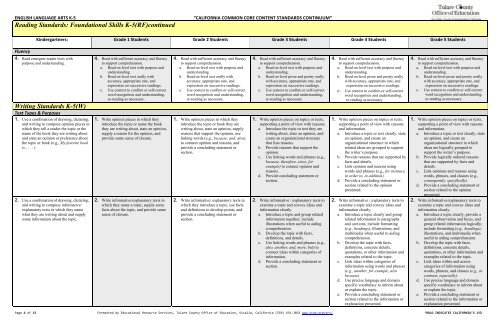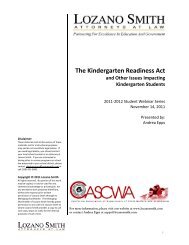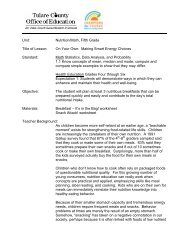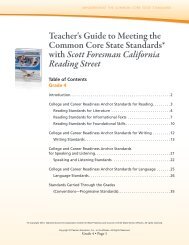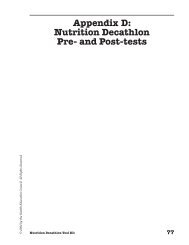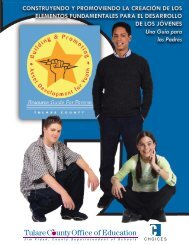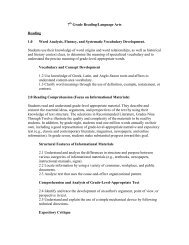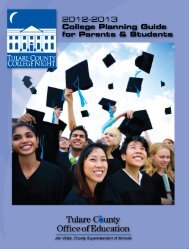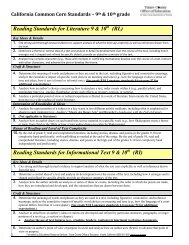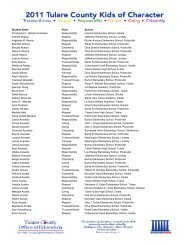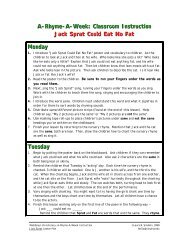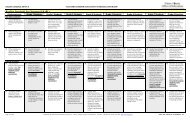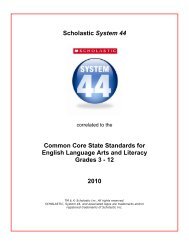CCCS K-5 ELA Continuum - Tulare County Office of Education
CCCS K-5 ELA Continuum - Tulare County Office of Education
CCCS K-5 ELA Continuum - Tulare County Office of Education
- No tags were found...
Create successful ePaper yourself
Turn your PDF publications into a flip-book with our unique Google optimized e-Paper software.
ENGLISH LANGUAGE ARTS K‐5 “CALIFORNIA COMMON CORE CONTENT STANDARDS CONTINUUM”Reading Standards: Foundational Skills K-5(RF)continuedKindergartners: Grade 1 Students Grade 2 Students Grade 3 Students Grade 4 Students Grade 5 StudentsFluency4. Read emergent-reader texts withpurpose and understanding.Writing Standards K-5(W)Text Types & Purposes1. Use a combination <strong>of</strong> drawing, dictating,and writing to compose opinion pieces inwhich they tell a reader the topic or thename <strong>of</strong> the book they are writing aboutand state an opinion or preference aboutthe topic or book (e.g., My favorite bookis.. . . . ).2. Use a combination <strong>of</strong> drawing, dictating,and writing to compose informative/explanatory texts in which they namewhat they are writing about and supplysome information about the topic.4. Read with sufficient accuracy and fluencyto support comprehension.a. Read on-level text with purpose andunderstanding.b. Read on-level text orally withaccuracy, appropriate rate, andexpression on successive readings.c. Use context to confirm or self-correctword recognition and understanding,re-reading as necessary.1. Write opinion pieces in which theyintroduce the topic or name the bookthey are writing about, state an opinion,supply a reason for the opinion, andprovide some sense <strong>of</strong> closure.2. Write informative/explanatory texts inwhich they name a topic, supply somefacts about the topic, and provide somesense <strong>of</strong> closure.4. Read with sufficient accuracy and fluencyto support comprehension.a. Read on-level text with purpose andunderstanding.b. Read on-level text orally withaccuracy, appropriate rate, andexpression on successive readings.c. Use context to confirm or self-correctword recognition and understanding,re-reading as necessary.1. Write opinion pieces in which theyintroduce the topic or book they arewriting about, state an opinion, supplyreasons that support the opinion, uselinking words (e.g., because, and, also),to connect opinion and reasons, andprovide a concluding statement orsection.2. Write informative/ explanatory texts inwhich they introduce a topic, use factsand definitions to develop points, andprovide a concluding statement orsection.4. Read with sufficient accuracy and fluencyto support comprehension.a. Read on-level text with purpose andunderstanding.b. Read on-level prose and poetry orallywith accuracy, appropriate rate, andexpression on successive readings.c. Use context to confirm or self-correctword recognition and understanding,re-reading as necessary.1. Write opinion pieces on topics or texts,supporting a point <strong>of</strong> view with reasons.a. Introduce the topic or text they arewriting about, state an opinion, andcreate an organizational structurethat lists reasons.b. Provide reasons that support theopinion.c. Use linking words and phrases (e.g.,because, therefore, since, forexample) to connect opinion andreasons.d. Provide concluding statement orsection.2. Write informative / explanatory texts toexamine a topic and convey ideas andinformation clearly.a. Introduce a topic and group relatedinformation together; includeillustrations when useful to aidingcomprehension.b. Develop the topic with facts,definitions, and details.c. Use linking words and phrases (e.g.,also, another, and, more, but) toconnect ideas within categories <strong>of</strong>information.d. Provide a concluding statement orsection.4. Read with sufficient accuracy and fluencyto support comprehension.a. Read on-level text with purpose andunderstanding.b. Read on-level prose and poetry orallywith accuracy, appropriate rate, andexpression on successive readings.c. Use context to confirm or self-correctword recognition and understanding,re-reading as necessary.1. Write opinion pieces on topics or texts,supporting a point <strong>of</strong> view with reasonsand information.a. Introduce a topic or text clearly, statean opinion, and create anorganizational structure in whichrelated ideas are grouped to supportthe writer’s purpose.b. Provide reasons that are supported byfacts and details.c. Link opinion and reasons usingwords and phrases (e.g., for instance,in order to, in addition).d. Provide a concluding statement orsection related to the opinionpresented.2. Write informative / explanatory texts toexamine a topic and convey ideas andinformation clearly.a. Introduce a topic clearly and grouprelated information in paragraphsand sections; include formatting(e.g., headings), illustrations, andmultimedia when useful to aidingcomprehension.b. Develop the topic with facts,definitions, concrete details,quotations, or other information andexamples related to the topic.c. Link ideas within categories <strong>of</strong>information using words and phrases(e.g., another, for example, alsobecause).d. Use precise language and domainspecific vocabulary to inform aboutor explain the topic.e. Provide a concluding statement orsection related to the information orexplanation presented.4. Read with sufficient accuracy and fluencyto support comprehension.a. Read on-level text with purpose andunderstanding.b. Read on-level prose and poetry orallywith accuracy, appropriate rate, andexpression on successive readings.c. Use context to confirm or self-correctword recognition and understanding,re-reading as necessary.1. Write opinion pieces on topics or texts,supporting a point <strong>of</strong> view with reasonsand information.a. Introduce a topic or text clearly, statean opinion, and create anorganizational structure in whichideas are logically grouped tosupport the writer’s purpose.b. Provide logically ordered reasonsthat are supported by facts anddetails.c. Link opinions and reasons usingwords, phrases, and clauses (e.g.,consequently, specifically).d. Provide a concluding statement orsection related to the opinionpresented.2. Write informative/explanatory texts toexamine a topic and convey ideas andinformation clearly.a. Introduce a topic clearly, provide ageneral observation and focus, andgroup related information logically;include formatting (e.g., headings),illustrations, and multimedia whenuseful to aiding comprehension.b. Develop the topic with facts,definitions, concrete details,quotations, or other information andexamples related to the topic.c. Link ideas within and acrosscategories <strong>of</strong> information usingwords, phrases, and clauses (e.g., incontrast, especially).d. Use precise language and domainspecific vocabulary to inform aboutor explain the topic.e. Provide a concluding statement orsection related to the information orexplanation presented.Page 4 <strong>of</strong> 15 Formatted by <strong>Education</strong>al Resource Services, <strong>Tulare</strong> <strong>County</strong> <strong>Office</strong> <strong>of</strong> <strong>Education</strong>, Visalia, California (559) 651‐3031 www.tcoe.org/ers/ *BOLD INDICATES CALIFORNIA’S 15%


